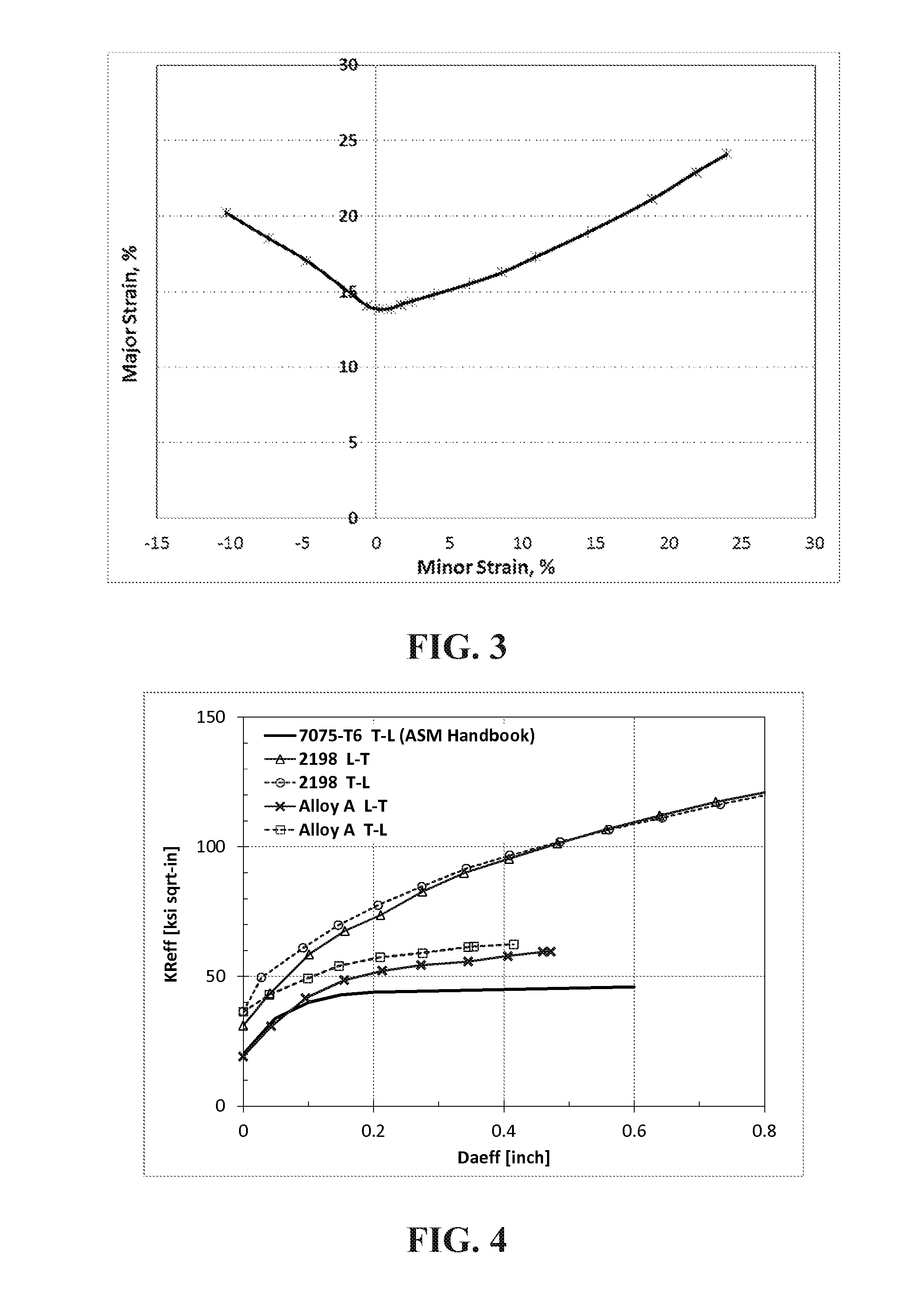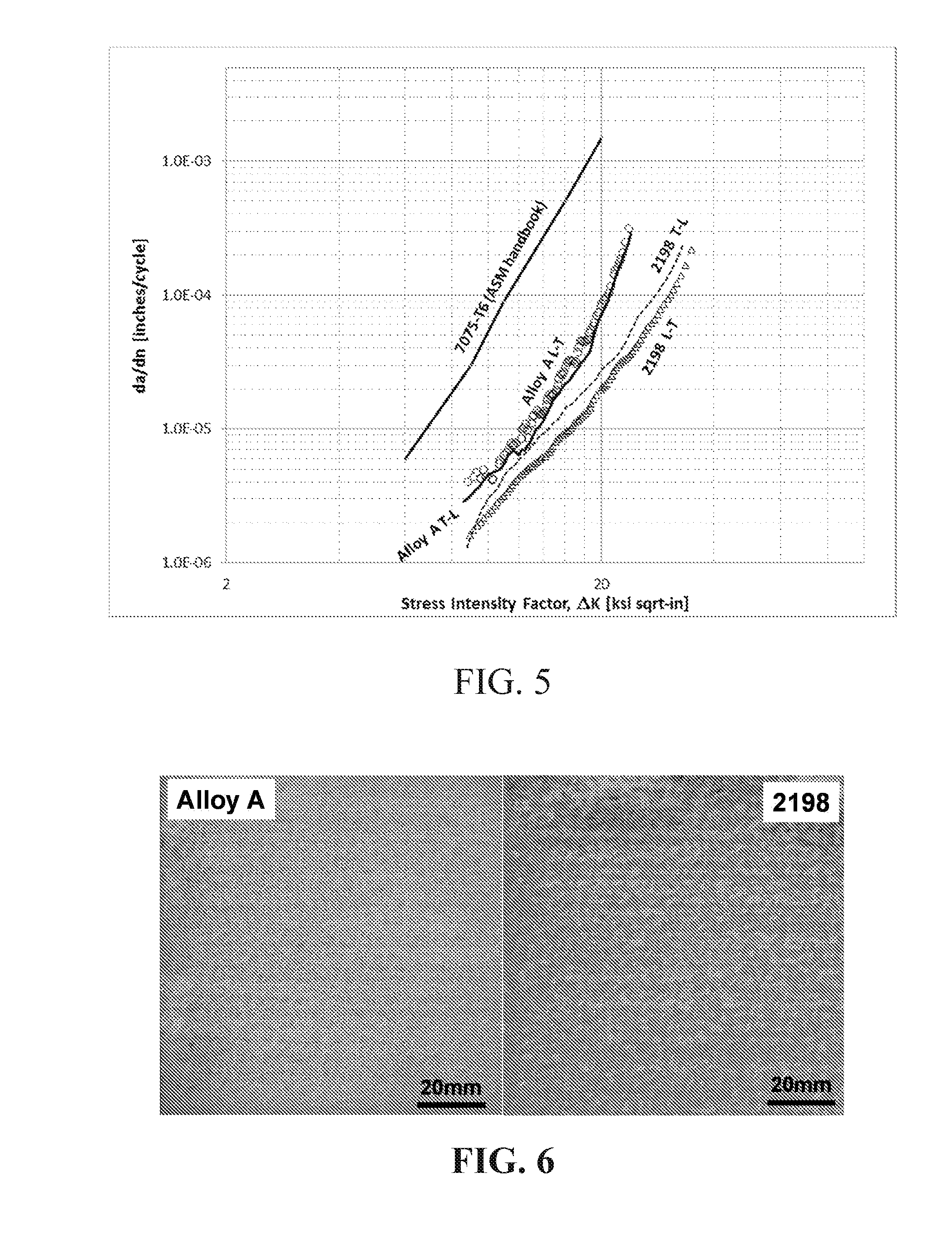High Strength, High Formability, and Low Cost Aluminum-Lithium Alloys
a technology of aluminum-lithium alloys and alloys, applied in the field of aluminum-copperlithiummagnesium based alloy products, can solve the problems of high manufacturing difficulty, high manufacturing difficulty, and difficult control of microstructure and texture, and achieve the effects of high formability, low cost and high strength
- Summary
- Abstract
- Description
- Claims
- Application Information
AI Technical Summary
Benefits of technology
Problems solved by technology
Method used
Image
Examples
example 1
Book Mold Ingot Based Product Study
[0055]Eleven book mold ingots with the approximate dimension of 1.25″×6″×12″ were cast and processed into 0.05″ sheet products. Table 2 gives the chemical compositions of these 11 book mold ingots. Among these 11 chemistries, #5 is not in the range of the inventive chemical composition due to very low Cu content. #6 to #11 ingots have about 0.3 wt. % Ag, therefore, are not in the inventive chemical composition range.
TABLE 2SampleInventionAlloy Compositions, wt. %IDalloy?CuLiMgAgZrZn1Invention3.71.21.00.070.382Invention3.81.01.30.070.363Invention4.01.30.80.070.394Invention4.01.00.80.050.385Not Invention3.31.01.30.070.366Not Invention3.61.11.00.290.080.007Not Invention3.91.31.10.280.070.008Not Invention4.11.41.40.290.080.009Not Invention4.11.40.80.280.070.0010Not Invention4.21.10.80.290.060.0011Not Invention4.21.11.30.290.080.00
[0056]Book mold ingots were surface scalped, homogenized, hot rolled, cold rolled, solution heat treated, quenched, stretche...
example 2
Full Scale Plant Trial
[0064]Two industrial scale 406mm (16″) thick ingots of the inventive alloys and one of the 2198 alloy were cast by DC (Direct Chill) casting process and processed to 0.05″ thickness sheets. The 2198 alloy was used as a baseline alloy. Table 5 gives the chemical compositions of industrial scale ingots of inventive alloys and 2198 alloy.
TABLE 5Alloy Chemical Compositions, wt. %AlloysSiFeCuMnMgZnZrLiAgAlloy A0.030.053.920.3400.980.360.081.110.00(Inven-tion)Alloy B0.030.054.020.3450.990.360.091.110.00(Inven-tion)21980.030.053.180.3500.540.020.100.910.27(Base-line)
[0065]The ingots were homogenized at temperature from 496 to 538° C. (925 to 1000° F.). The hot rolling temperatures were from 371 to 466° C. (700 to 870° F.). The ingots were hot rolled at multiple passes into 0.06 to 0.20″ thickness. Although the cold rolling is optional, all sheets were further cold rolled to 0.05″ thickness. The cold rolled sheets were solution heat treated at a temperature range from ...
PUM
| Property | Measurement | Unit |
|---|---|---|
| yield strength | aaaaa | aaaaa |
| yield strength | aaaaa | aaaaa |
| temperatures | aaaaa | aaaaa |
Abstract
Description
Claims
Application Information
 Login to View More
Login to View More - R&D
- Intellectual Property
- Life Sciences
- Materials
- Tech Scout
- Unparalleled Data Quality
- Higher Quality Content
- 60% Fewer Hallucinations
Browse by: Latest US Patents, China's latest patents, Technical Efficacy Thesaurus, Application Domain, Technology Topic, Popular Technical Reports.
© 2025 PatSnap. All rights reserved.Legal|Privacy policy|Modern Slavery Act Transparency Statement|Sitemap|About US| Contact US: help@patsnap.com



